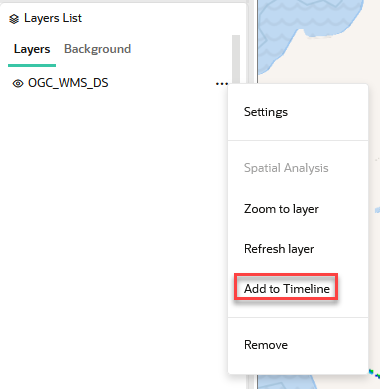3.10.2.5.3 About Map Layers and the Timeline
Learn more about the spatiotemporal map layers and the Cesium timeline.
- In order to add a map layer to the timeline, you must first enable spatiotemporal in the underlying dataset for the map layer. See Enabling Spatiotemporal for a Dataset for more information.
- You can then add one or more spatiotemporal map layers to the Cesium
timeline by performing the following steps:
- Click the Settings icon in your map tool bar and switch
ONthe Show timeline toggle to view the Cesium timeline widget at the bottom of the map visualization canvas. - Select the Add to Timeline option in
the context menu of the map layer as shown:
Figure 3-61 Adding a Map Layer to the Timeline

Description of "Figure 3-61 Adding a Map Layer to the Timeline"The map layer gets added to the timeline.
- Click the Settings icon in your map tool bar and switch
- Note the following if you add multiple map layers to the timeline:
- Each of these map layers respond to the timeline events
independently. Therefore, you can configure each map layer to have its own
properties (such as refresh time) and they then accordingly respond to the
listener events. As the timeline events are thrown at every
500mstick interval, each layer can have it own refresh time (more than500ms) as to when they want to respond to these events. - Also, in case of the map layers for datasets with historic timestamp values, all layers will loop back as per the current timeline range. This may either correspond to the first layer added to the timeline or it can be a custom range that you set in the timeline settings.
- If a layer corresponding to a live dataset is added to the timeline, then irrespective of the historic dataset layers listening to the timeline already, the timeline will never loop back and will keep moving forward.
- Each of these map layers respond to the timeline events
independently. Therefore, you can configure each map layer to have its own
properties (such as refresh time) and they then accordingly respond to the
listener events. As the timeline events are thrown at every
- If you make any changes to the underlying dataset properties of a map
layer, which is already added to the timeline, such as:
-
- Disabling the Enable Spatiotemporal toggle
- Toggling Data is Live and Moving Objects
Then, the listener gets removed from the timeline. In such cases, it is recommended that you remove the layer from the timeline and add it again after changing the properties.
- If you change the Time Unit property of a standard filtering dataset, then this will take effect immediately and the filtering on the map visualization will adhere to the new Time Unit value.
-
Parent topic: Visualizing Spatiotemporal Datasets